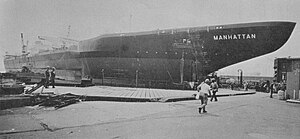SS Manhattan (1961)
This article includes a list of general references, but it lacks sufficient corresponding inline citations. (September 2013) |
 SS Manhattan in 1969
| |
| History | |
|---|---|
| Builder | Fore River Shipyard |
| Launched | 18 December 1961 |
| Identification | IMO number: 5219369 |
| Fate | Scrapped c.1987 |
| General characteristics as built | |
| Type | Oil tanker |
| Tonnage | 105,000 deadweight tonnage |
| Length | 940 ft (290 m) |
| Beam | 132 ft (40 m) |
| Speed | 17–18 knots (31–33 km/h; 20–21 mph) |
| General characteristics post conversion | |
| Type | Oil tanker icebreaker |
| Tonnage | 115,000 deadweight tonnage |
| Length | 1,005 ft (306 m) |
| Beam | 148 ft (45 m) |
| Draft | 52 ft (16 m) |
| Installed power | 43,000 shp (32,000 kW) |
| Speed | 17 knots (31 km/h; 20 mph) |
SS Manhattan was an oil tanker constructed at the Fore River Shipyard in Quincy, Massachusetts, that became the first commercial ship to cross the Northwest Passage in 1969. Having been built as an ordinary tanker in 1962, she was refitted for ice navigation during this voyage with an icebreaker bow in 1968–69.
Registered in the United States at the time, she was the largest US merchant vessel.[1]
In 1965, she was taken to Portland, Oregon via the Columbia River, to be cleaned and used to transport 50,000 tons of grain. The size and draught of the ship required careful preparations for her transit on the river.[2]

Manhattan remained in service until 1987. After an accident in East Asia she was scrapped in China.
1969 Northwest Passage transit
Manhattan's route began in August 1969 from a berth on the Delaware River near Chester Pa.

This route through the Northwest Passage was quite controversial in international relations as sovereignty of these waters is claimed by Canada and this claim has been disputed by the United States. The
The voyage prompted passionate discussions in Canada about
The official reason for the voyage revolved around oil that had been discovered at
Icebreaker design using ice models
The conversion of Manhattan was a co-operation between its owner Esso and Wärtsilä, a Finnish shipbuilding company. Esso motivated for the use of models to optimize the ice breaking performance of the vessel, therefore the Wärtsilä Icebreaking Model Basin (WIMB) ice tank was built inside a converted air raid shelter in Helsinki, Finland, solely for this project. It was later used for Wärtsilä's own purposes until it was replaced by a new facility in the 1980s. Aker Arctic Technology, the Finnish engineering company that now uses the new ice tank thus owes its existence to the Manhattan project.[5]
In popular culture
In 1969, the SS Manhattan gave rise to a board game based on its Northwest Passage transit, fittingly titled Northwest Passage![6][7]
See also
- Territorial claims in the Arctic
- Northern Sea Route
- Icebreaker-transport vessel
References
- Notes
- ^ Comptroller General of the United States. Annual Report - 1974 - United States General Accounting Office. U.S. General Accounting Office. p. 155.
- ^ Duke, Bob (21 April 2015). "Water Under the Bridge". The Astorian. Archived from the original on 30 May 2020. Retrieved 30 May 2020.
- ^ a b "A $40 Million Gamble on the Northwest Passage". Time. 5 September 1969. p. 75.
- ^ "SS Manhattan". Maritime Logistics Professional. 17 April 2012.
- ^ Wilkman, Göran (2009). "40 years of ice model testing" (PDF). Helsinki, Finland: Aker Arctic Technology. Archived from the original (PDF) on 22 October 2016.
- ^ "Northwest Passage! (1969), Board Game Geek, https://boardgamegeek.com/boardgame/7454/northwest-passage
- ^ "Northwest Passage! – Review and How to Play," YouTube, uploaded 12 April 2020, https://www.youtube.com/watch?v=BJlR0QLWFmI
- Sources
- Keating, Bern; Sennett, Tomas (March 1970). "Through the Northwest Passage for Oil". National Geographic. Vol. 137, no. 3.
- Byers, Michael (September 2006). On Thinning Ice. University of British Columbia (Podcast).
- Smith, William D. (1970). Northwest Passage, The Historic Voyage of the S.S. Manhattan. American Heritage. ISBN 978-0-07-058460-0.
- "S.S. Manhattan & the Northwest Passage". Sun Ship Historical Society. 12 July 2005.
Further reading
- Coen, Ross (2012). Breaking Ice for Arctic Oil: The Epic Voyage of the SS Manhattan Through the Northwest Passage. University of Alaska Press. ISBN 978-1-60223-169-6.
External links
- "The First Arctic Tanker". Surveyor. American Bureau of Shipping: 18. Summer 2005.
- Gedney, Larry; Helfferich, Merritt (19 December 1983). "Voyage of the Manhattan". Alaska Science Forum. Geophysical Institute, University of Alaska Fairbanks. 639.
- "Voyage of Arctic discovery". International Esso Tankers. Archived from the original on 14 March 2012.
- "Polar Voyage Manhattan". International Esso Tankers (in Dutch). Archived from the original on 14 March 2012.
- "Foreign Relations of the United States, 1969–1976". Office of the Historian. United States Department of State. 12 March 1970. Imminent Canadian Legislation on the Arctic. Document 367.
